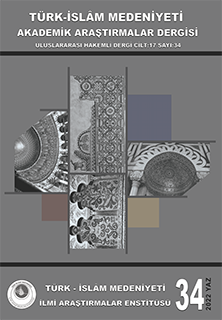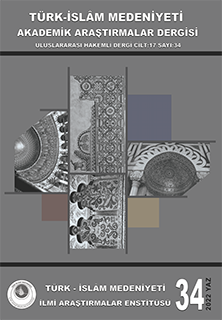An Essay on the Classification of Muqarnas: Geometric Foundations Based on Application in Practice
DOI:
https://doi.org/10.5281/zenodo.6468626Keywords:
Muqarnas, Islamic Art and Architecture, Geometric Pattern, Islamic OrnamentAbstract
The main objective of this paper is to introduce a new approach to analyzing muqarnas units. Although there are many studies in this area, most of them are not comprehensive and treat the subject from a narrow perspective. The basic approach consists of using al-Kashi’s work as a point of reference. But, since examples of units of the muqarnas technique are many and varied, a new approach needs to be developed to define them. This article consists of three sections. The first covers etymological discussions in the field; the second explains the methods that have been used to analyze muqarnas units. Finally, the third section will present a way of classifying muqarnas units on geometric foundations. It is believed that this article will contribute to the field by creating a way of classifying muqarnas units in historical context and adding a new perspective to the debates in this field over their origins.
References
Alaçam, S., Güzelci, O. Z., Gürer, E., Bacınoğlu, S. Z. (2017). Reconnoitring computational potentials of the vault-like forms: Thinking aloud on muqarnas tectonics. International Journal of Architectural Computing, 15(4), 285-303.
Arseven, C. E. (1973). Türk Sanatı. Cem Yayınevi.
Bloom, J. M. (1988). The Introduction of the Muqarnas into Egypt. Muqarnas, 5, 21.
Büyükdiğan, İ. (2001). Muqarnas Domes in Edirne. Architectural Science Review, 44(2), 161-171.
Carrillo, A. (2014). Architectural exchanges between North Africa and the Iberian Peninsula: Muqarnas in al-Andalus. The Journal of North African Studies, 19(1), 68-82.
Castera, J. M. (2006). The Muqarnas Dome of the Hall of the Two Sisters in the Alhambra in Granada. in Mathematics and Culture V. Springer-Verlag.
Dinçer, S. G., Yazar, T. (2021). A comparative analysis of the digital reconstructions of muqarnas systems: The case study of Sultanhanı muqarnas in Central Anatolia. International Journal of Architectural Computing.
Dold-Samplonius, Y. (1992). Pratctical Arabic Mathematics: Measuring The Muqarnas by al-Kâshî. Centaurus, 35, 193-242.
Dold-Samplonius, Y., Harmsen, S. L. (2005). The Muqarnas Plate Found at Takht-i Sulayman: A New Interpretation. Muqarnas Online, 22(1), 85-94.
Garofalo, V. (2011). A Methodology for Studying Muqarnas: The Extant Examples in Palermo. Muqarnas Online, 27(1), 357-406.
Ghazarian, A., Ousterhout, R. (2001). A Muqarnas Drawing from ThirteenthCentury Armenia and the Use of Architectural Drawings during the middle Ages. Muqarnas, 18, 141.
Gonzalo, J. C. P., Alkadi, R. M. (2018). Muqarnas Domes and Cornices in the Maghreb and Andalusia. Nexus Network Journal, 20(1), 95-123.
Güzelci, O. Z.; Alaçam, S. (2019). A Study on Measuring Complexity in Muqarnas Patterns. TURKISH ONLINE JOURNAL OF DESIGN ART AND COMMUNICATION, 9(2), 191-201.
Haddad, M. (2015). Ebu’l-Vefa’nın “Fima Yahtacü İleyhi’s-Süna’ü min A’mâli-l Hendasati” kitabının Geometrik Tezyinata Katkısı. Marmara Üniversitesi Sosyal Bilimler Enstitüsü Basılmamış Yüksek Lisans Tezi.
Kāshī, J. ibn M., Kāshī, J. ibn M., Kāshī, J. ibn M., Aydin, N., Hammoudi, L., Bakbouk, G. (2020). Al-Kāshī’s Miftāḥ al ḥisab. Translation and commentary Volume II, Volume II,.
……….. Minaret of Grand Mosque of Aleppo . https://www.selcuklumirasi.com/architecture-detail/aleppo-greatmosque.
Nasri, A., Samavati, F. F., Hamekasi, N. (2011). Interactive Modeling of Muqarnas. Computational Aesthetics in Graphics, Visualization, and Imaging.
Necipoğlu, G., Al-Asad, M. (1995). The Topkapı scroll: Geometry and ornament in Islamic architecture: Topkapı Palace Museum Library MS H. 1956. Getty Center for the History of Art and the Humanities.
Notkin, I. I. (1994). Decoding Sixteenth-Century Muqarnas Drawings. Muqarnas Online, 12(1), 148-171. https://doi.org/10.1163/22118993-90000351.
Ödekan, A. (1975). Bir Mukarnaslı Portal Yarım Kubbesi Geometrik Semadan Üçncü Boyuta Geçiş Örneği. İçinde İsmail Hakkı Uzunçarşılı Armağanı’ndan Ayrı Basım. Türk Tarih Kurumu.
Özdural, A. (1990). Gıyaseddin Jemsid el-Kashi and Stalactites. METU JFA, 10(12), 31-49.
Özdural, A. (1991). Analysis of the Geometry of Stalactites: Buruciye Medrese in Sivas. METU JFA, 11(1-2), 57-71.
Senhaji, M., Benslimane, R. (2019). Automatic 3D muqarnas architectural patterns reconstruction using plane representation. Journal of Cultural Heritage, 35, 25-40.
Tabbaa, Y. (1985). The Muqarnas Dome: Its Origin and Meaning. Muqarnas, 3, 61.
Uluçam, A. (1990). Irak’taki Mukarnas Kubbeli Selçuklu Türbeleri Hakkında. Vakıflar Dergisi, XXII, 255-280.
Yaghan, M. A. J. (2000). Decoding the Two-Dimensional Pattern Found at TakhtI Sulayman into Three-Dimensional Muqarnas Forms. Iran, 38(1), 77-95.
Yaghan, M. A. J. (2003). Gadrooned-Dome’s Muqarnas-Corbel: Analysis and Decoding Historical Drawings. Architectural Science Review, 46(1), 69-88.
Downloads
Published
How to Cite
Issue
Section
License

This work is licensed under a Creative Commons Attribution-NonCommercial 4.0 International License.







